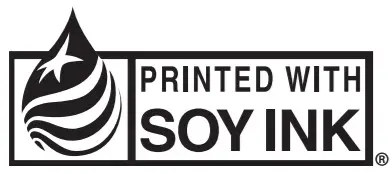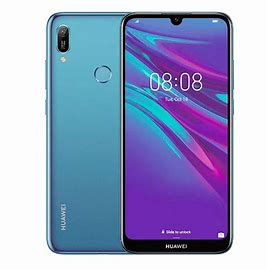

 Quick Start Guide
Quick Start Guide
Know Your Device
Before using the device, familiarize yourself with its basic operations.
- To power on your device, press and hold the power button until the screen turns on.
- To power off your device, press and hold the power button, and then touch

- To restart your device, press and hold the power button, and then touch

- Press and hold the power button for 10 or more seconds to forcibly restart your device.
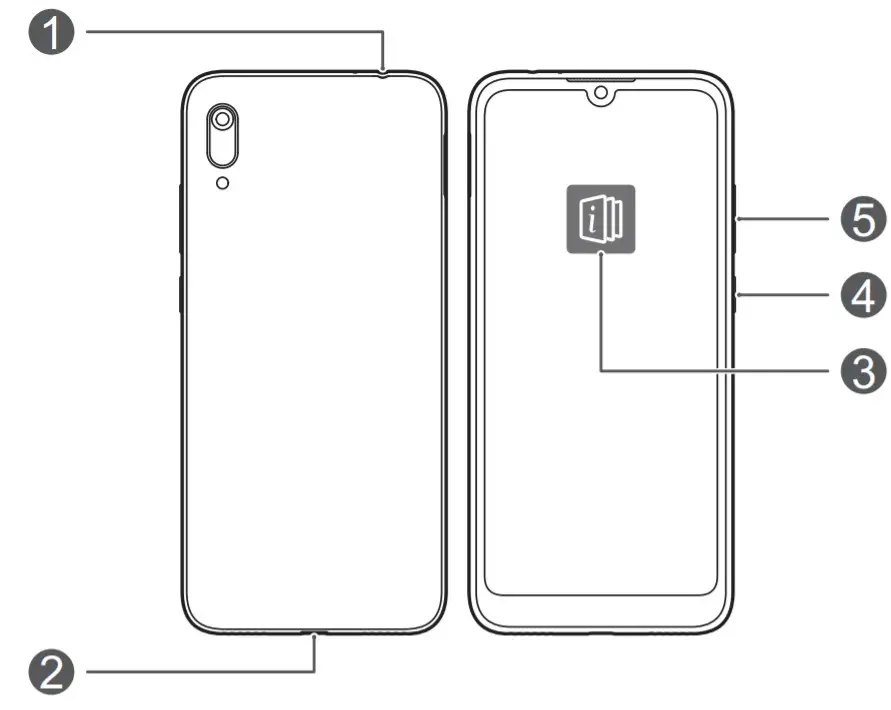
| 1.Headset jack | 4.Power button |
| 2.Micro-USB port | 5.Volume button |
| 3.Tips App |
 Check out the pre-installed Tips app and master all the great features on your device.
Check out the pre-installed Tips app and master all the great features on your device.
Getting Started
 Do not insert or remove the SIM card when your device is powered on.
Do not insert or remove the SIM card when your device is powered on.- Ensure that the card is correctly aligned and that the
card tray is level when you insert it into your device.  Be careful not to scratch your device or hurt yourself when using the eject pin.
Be careful not to scratch your device or hurt yourself when using the eject pin.- Store the eject pin out of the reach of children to
prevent accidental swallowing or injury.  Do not use cut or modified SIM or microSD cards with your device as these may not be recognized and could damage the card tray (slot).
Do not use cut or modified SIM or microSD cards with your device as these may not be recognized and could damage the card tray (slot).- If your SIM card does not match your device, please contact your carrier.
Follow the instructions in the following figures to set up your device. Please use the eject pin included.
Single-SIM:

Dual-SIM:
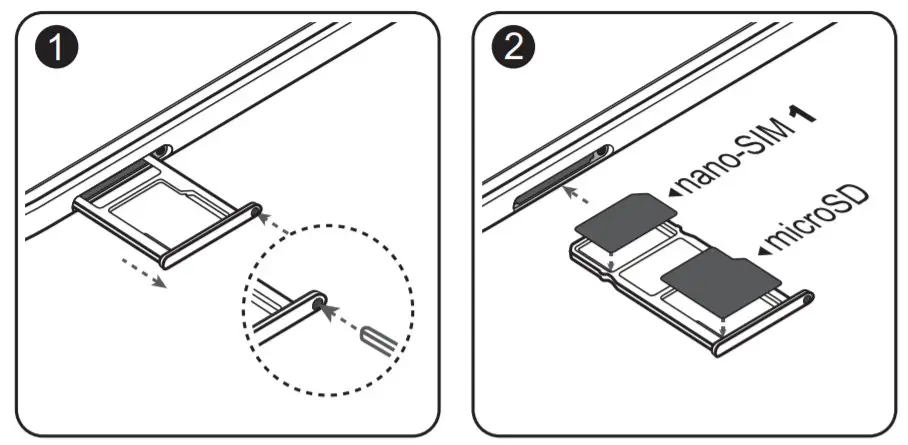
Dual Card Dual Standby Single Pass (dual-SIM devices only)
Your device supports only dual card dual standby single pass, which means you cannot use both SIM cards for calls or data services simultaneously.
- When you are on a call using a SIM card
1, SIM card 2 cannot be used to make or answer calls. If someone calls SIM card
2, the caller will hear a voice message similar to “The subscriber you dialed is out of the service area” or “The subscriber you dialed cannot be connected for the moment, please try again later.” The actual message will vary by service provider. - When you are using SIM card 1’s data service, SIM card 2’s data service will be disabled.
Your device’s single-pass feature helps reduce power consumption and increase your device’s standby time. It is not related to your service provider’s network conditions.
 You can enable call forwarding between SIMs on the device to avoid missed calls.
You can enable call forwarding between SIMs on the device to avoid missed calls.
For More Information
If you encounter any problems while using your device, you can obtain help from the following resources:
- Visit http://consumer.huawei.com/en to view the device information frequently asked questions and other information.
- Visit http://consumer.huawei.com/en/support for the most up-to-date contact information for your country or region.
- You can find service hotlines, retailer addresses, service policies, and more information for your local region in HiCare.
Go to Settings and touch System > About phone > Legal to view legal information for your product.
Go to Settings and touch System > About phone > Legal > Safety information to view safety information for your product.
Go to Settings and touch System > About phone > Authentication info to view regulatory information for your product.
Go to Settings and touch System > Certification logos to view more information on certification logos for your product.
 All pictures and illustrations in this guide, including but not limited to the device color, size, and display content, are for your reference only. The actual device may vary.
All pictures and illustrations in this guide, including but not limited to the device color, size, and display content, are for your reference only. The actual device may vary.
Nothing in this guide constitutes a warranty of any kind, express or implied.
Safety Information
Please read all of the safety information carefully before using your device to ensure its safe and proper operation and to learn how to dispose of your
device properly.
Operation and safety
 To prevent possible hearing damage, do not listen at high volume levels for long periods.
To prevent possible hearing damage, do not listen at high volume levels for long periods.- Using an unapproved or incompatible power adapter, charger, or battery may damage your device, shorten its lifespan, or cause a fire, explosion, or other hazards.
- Ideal operating temperatures are 0 °C to 35 °C. Ideal storage temperatures are -20 °C to +45 °C.
- Pacemaker manufacturers recommend that a minimum distance of 15 cm be maintained between a device and a pacemaker to prevent potential interference with the pacemaker. If using a pacemaker, hold the device on the side opposite the pacemaker and do not carry the device in your front pocket.
- Keep the device and the battery away from fire, excessive heat, and direct sunlight. Do not place them on or in heating devices, such as microwave ovens, water heaters, stoves, or radiators.
- Adhere to local laws and regulations while using the device. To reduce the risk of accidents, do not use your wireless device while driving. If you must make or answer a call, stop your vehicle at a safe location first.
- While flying in an aircraft or immediately before boarding, only use your device according to the instructions provided. Use of a wireless device in an
aircraft may disrupt wireless networks, present a hazard to aircraft operation, or be illegal. - To prevent damage to your device’s parts or internal circuits, do not use it in dusty, smoky, damp, or dirty environments or near magnetic fields.
- When charging the device, make sure the power adapter is plugged into a socket near the device and is easily accessible.
- Unplug the charger from electrical outlets and the device when not in use.
- Do not use, store, or transport the device where flammables or explosives are stored (in a gas station, oil depot, or chemical plant, for example). Using your device in these environments increases the risk of explosion or fire.
- Dispose of this device, the battery, and accessories according to local regulations. They should not be disposed of in the normal household waste.
Improper battery use may lead to fire, explosion, or other hazards. - Please consult your doctor and the device manufacturer to determine if the operation of your phone may interfere with the operation of your medical device.
- Adhere to any rules or regulations set forth by hospitals and health care facilities.
Potentially Explosive Atmosphere
Power off your device in any area with a potentially explosive atmosphere, and comply with all signs and instructions. Areas that may have potentially
explosive atmospheres include the areas where you would normally be advised to turn off your vehicle engine. The triggering of sparks in such areas could cause an explosion or a fire, resulting in bodily injuries or even deaths. Do not power on your device at refueling points such as service stations. Comply with restrictions on the use of radio equipment in fuel depots, storage, and distribution areas, and chemical plants. In addition, adhere to restrictions in areas where blasting operations are in progress. Before using the device, watch out for areas that have potentially explosive atmospheres that are often, but not always, clearly marked. Such locations include areas below the deck on boats, chemical transfer or storage facilities, and areas where the air contains chemicals or particles such as grain, dust, or metal powders. Ask the manufacturers of vehicles using liquefied petroleum gas (such as propane or butane) whether this device can be safely used in their vicinity.
Disposal and recycling information
 The crossed-out wheeled bin symbol on your product, battery, literature or the packaging reminds you that all electronic products and batteries must be taken to separate waste collection points at the end of their working lives; they must not be disposed of in the normal waste stream with household garbage. It is the responsibility of the user to dispose of the equipment using a designated collection point or service for separate recycling of waste electrical and electronic equipment (WEEE) and batteries according to local laws.
The crossed-out wheeled bin symbol on your product, battery, literature or the packaging reminds you that all electronic products and batteries must be taken to separate waste collection points at the end of their working lives; they must not be disposed of in the normal waste stream with household garbage. It is the responsibility of the user to dispose of the equipment using a designated collection point or service for separate recycling of waste electrical and electronic equipment (WEEE) and batteries according to local laws.
Proper collection and recycling of your equipment help ensure electrical and electronic equipment (EEE) waste is recycled in a manner that conserves valuable materials and protects human health and the environment, improper handling, accidental breakage, damage, and/or improper recycling at the end of its life may be harmful to health and environment. For more information about where and how to drop off your EEE waste, please contact your local authorities, retailer, or household waste disposal service or visit the website http://consumer.huawei.com/en/.
Reduction of hazardous substances
This device and its electrical accessories are compliant with local applicable rules on the restriction of the use of certain hazardous substances in electrical and electronic equipment, such as EU REACH, RoHS, and Batteries (where included) regulations. For declarations of conformity about REACH and RoHS, please visit our website http://consumer.huawei.com/ certification.
EU regulatory conformance
Body-worn operation
The device complies with RF specifications when used near your ear or at a distance of 0.50 cm from your body. Ensure that the device accessories, such as a device case and device holster, are not composed of metal components. Keep the device away from your body to meet the distance requirement.
The highest SAR value reported for this device type when tested at the ear is
| MRD-LX1 | 0.33 W/kg |
And when properly worn on the body is
| MRD-LX1 | 1.05 W/kg |
Statement
Hereby, Huawei Technologies Co., Ltd. declares that this device MRD-LX1 is in compliance with the essential requirements and other relevant provisions of Directive 2014/53/EU and 2011/65/EU.
The most recent and valid version of the DoC (Declaration of Conformity) can be viewed at http://consumer.huawei.com/certification.
This device may be operated in all member states of the EU.
Observe national and local regulations where the device is used.
This device may be restricted for use, depending on the local network.
Restrictions in the 2.4 GHz band:
Norway: This subsection does not apply to the geographical area within a radius of 20 km from the center of Ny-Ålesund.
Frequency Bands and Power
(a) Frequency bands in which the radio equipment operates: Some bands may not be available in all countries or all areas. Please contact the local carrier for more details.
(b) Maximum radio-frequency power transmitted in the frequency bands in which the radio equipment operates: The maximum power for all bands is
less than the highest limit value specified in the related Harmonized Standard.
The frequency bands and transmitting power (radiated and/or conducted) nominal limits applicable to this radio equipment are as follows:
| MRD-LX1 | GSM900: 35 dBm, GSM1800: 32 dBm, WCDMA900/2100: 25.7 dBm, LTE Band 1/3/7/8/20: 25.7 dBm, Wi-Fi 2.4G: 20 dBm, Bluetooth: 10 dBm |
Accessories and Software Information
Some accessories are optional in certain countries or regions. Optional accessories can be purchased from a licensed vendor as required. The following accessories are recommended:
Adapters: HW-050100X01 (X represents the different plug types used, which can be either C, U, J, E, B, A, I, R, Z or K, depending on your region) Batteries: HB405979ECW
Earphones: 1293-3283-3.5mm-322, MEND1532B528A02
The product software version is MRD-LX1: 5.0.1.57(SP1C900E64R1P3).
Software updates will be released by the manufacturer to fix bugs or enhance functions after the product has been released. All software versions released by the manufacturer have been verified and are still compliant with the related rules.
All RF parameters (for example, frequency range and output power) are not accessible to the user, and cannot be changed by the user.
For the most recent information about accessories and software, please see the DoC (Declaration of Conformity) at http://consumer.huawei.com/ certification.
FCC Regulatory Compliance
Body-worn operation
The device complies with RF specifications when used near your ear or at a distance of 1.50 cm from your body. Ensure that the device accessories,
such as a device case and device holster, are not composed of metal components. Keep the device away from your body to meet the distance requirement.
Certification information (SAR)
This device is also designed to meet the requirements for exposure to radio waves established by the Federal Communications Commission (USA).
The SAR limit adopted by the USA is 1.6 W/kg averaged over one gram of tissue. The highest SAR value reported to the FCC for this device type
complies with this limit.
The highest SAR value reported to the FCC for this device type when using it at the ear is
| MRD-LX1 | 0.62 W/kg |
And when properly worn on the body is
| MRD-LX1 | 0.47 W/kg |
And when using the Wi-Fi hotspot function is
| MRD-LX1 | 0.47 W/kg |
FCC statement
This equipment has been tested and found to comply with the limits for a Class B digital device, pursuant to Part 15 of the FCC Rules. These limits are
designed to provide reasonable protection against harmful interference in a residential installation. This equipment generates, uses and can radiate radio frequency energy and, if not installed and used in accordance with the instructions, may cause harmful interference to radio communications.
However, there is no guarantee that interference will not occur in a particular installation. If this equipment does cause harmful interference to radio or television reception, which can be determined by turning the equipment off and on, the user is encouraged to try to correct the interference by one or more of the following measures:
–Reorient or relocate the receiving antenna.
–Increase the separation between the equipment and receiver.
–Connect the equipment into an outlet on a circuit different from that to which the receiver is connected.
–Consult the dealer or an experienced radio/TV technician for help.
This device complies with Part 15 of the FCC Rules. Operation is subject to the following two conditions: (1) this device may not cause harmful interference, and (2) this device must accept any interference received, including interference that may cause undesired operation.
Caution: Any changes or modifications to this device not expressly approved by Huawei Technologies Co., Ltd. for compliance could void the user’s authority to operate the equipment.
Legal Notice
Trademarks and Permissions

 and
and 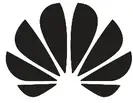 are trademarks or registered
are trademarks or registered
trademarks of Huawei Technologies Co., Ltd.
Android™ is a trademark of Google Inc.
LTE is a trademark of ETSI.
The Bluetooth® word mark and logos are registered trademarks owned by
Bluetooth SIG, Inc. and any use of such marks by Huawei Technologies Co., Ltd. is under license.
Wi-Fi®, the Wi-Fi CERTIFIED logo, and the Wi-Fi logo are trademarks of Wi-Fi Alliance.
Privacy Policy
To better understand how we protect your personal information, please see the privacy policy at http://consumer.huawei.com/privacy-policy.
Copyright © Huawei Technologies Co., Ltd. 2019. All rights reserved.
THIS DOCUMENT IS FOR INFORMATION PURPOSES ONLY AND DOES NOT CONSTITUTE ANY KIND OF WARRANTIES.

